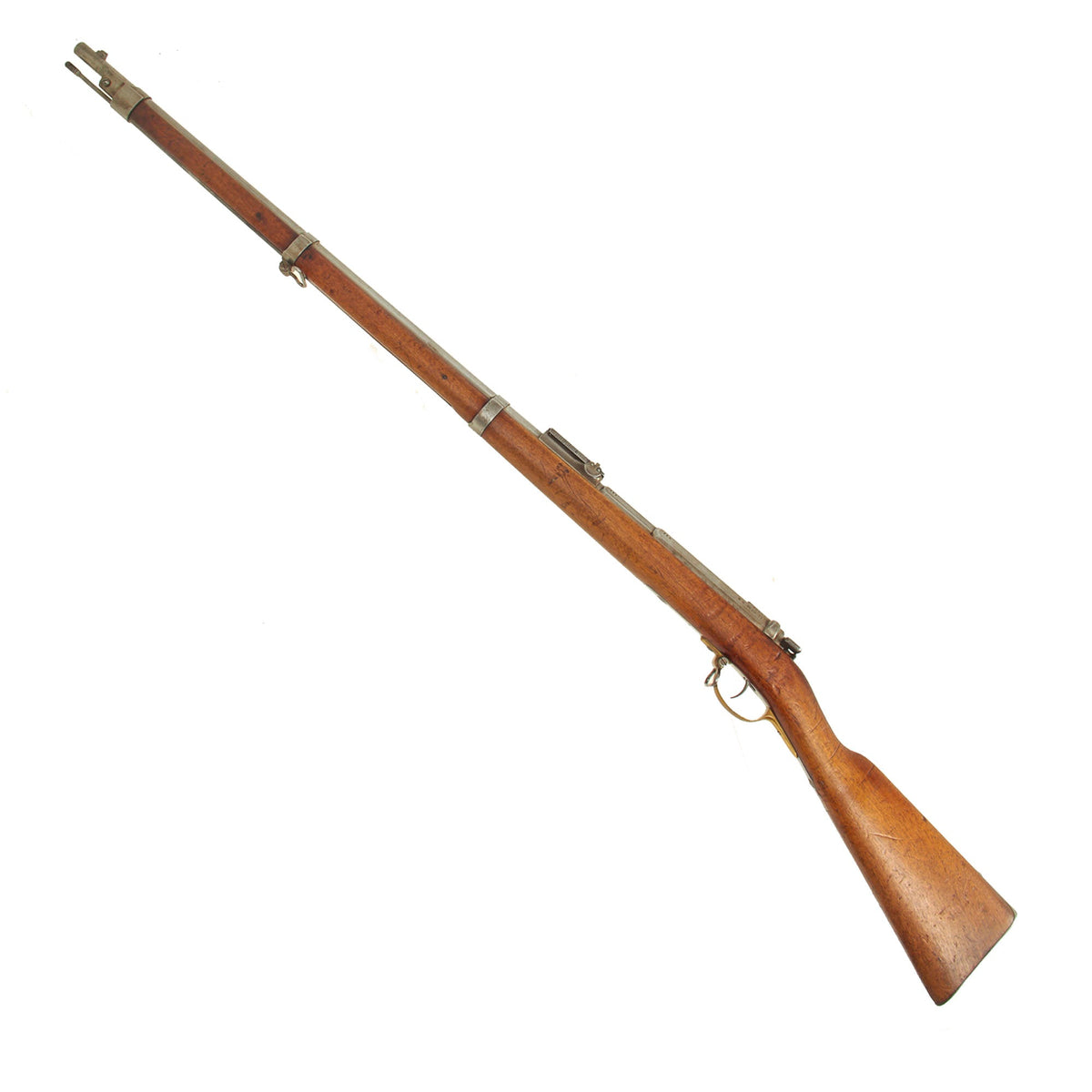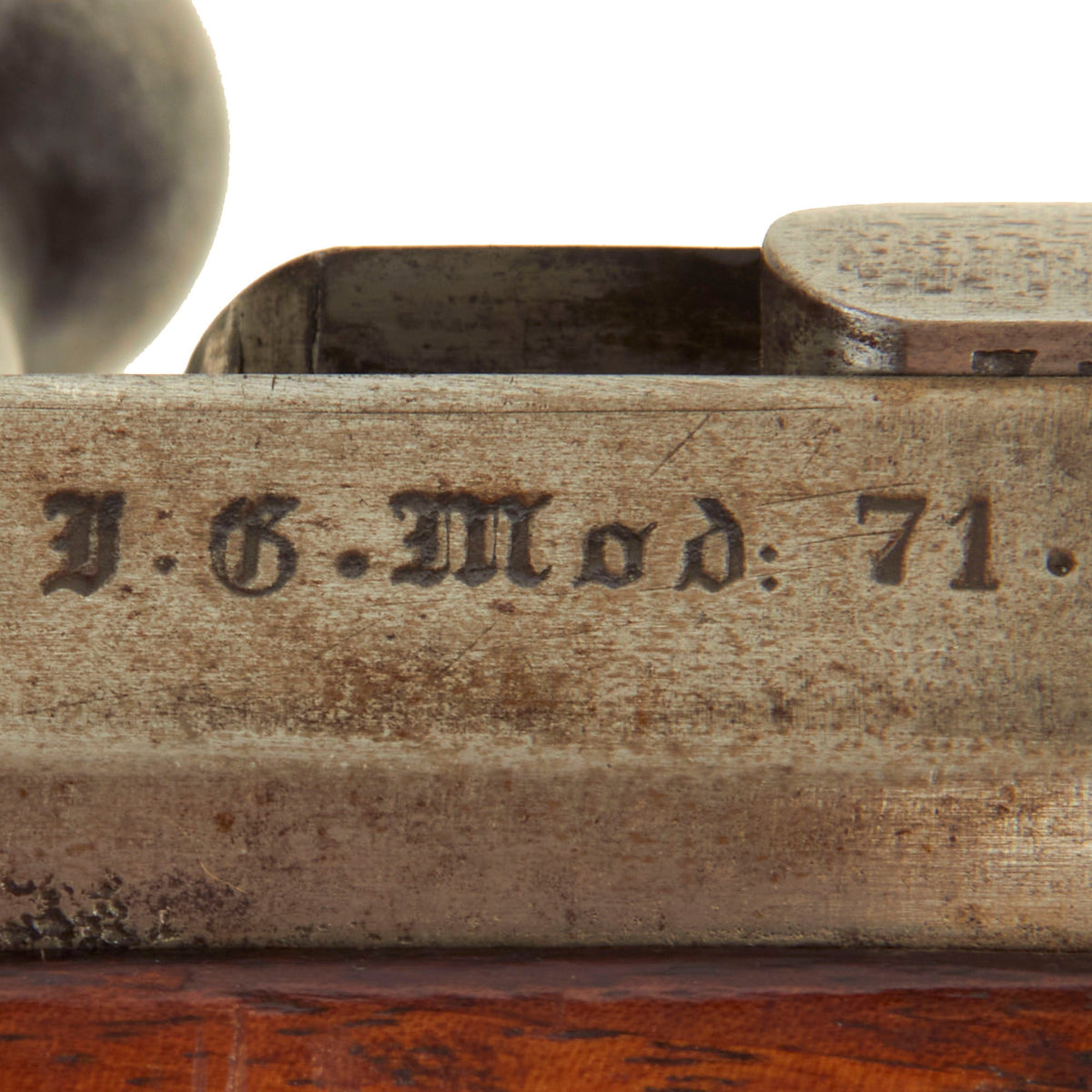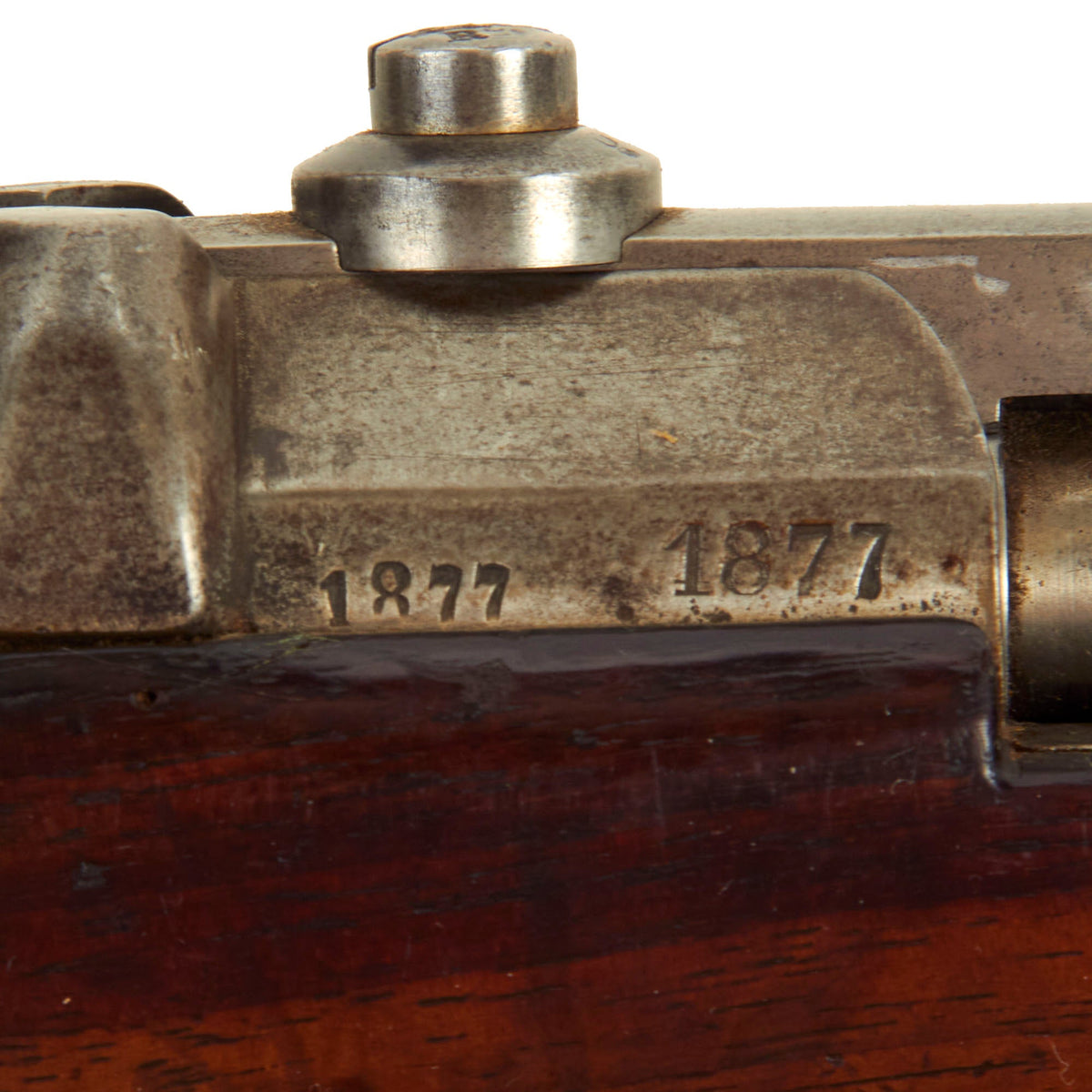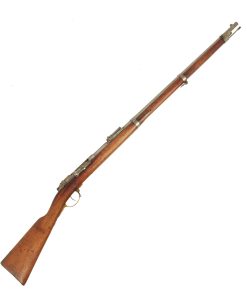Original German Mauser Model 1871 Bavarian Regt. Marked Infantry Rifle by Amberg dated 1877 – Matching Serial 389 Original Items
$ 1.995,00 $ 498,75
Original Item: Only One Available. This is a fantastic early example of the Mauser Model 1871 Infantry Rifle, manufactured by Amberg Arsenal in what was then the kingdom of Bavaria in the German Empire. It is covered with Imperial German inspection and acceptance markings on the metalwork. It bears serial number 389 on the barrel, receiver, bolt, barrel bands, and rear sight, with shortened number 89 present on many other components. That makes this a very desirable “ALL MATCHING” example, with no parts swapped out over the years, and it’s a great one!
The receiver is dated 1883 and marked I. G. M/71 on the opposite side in German “Black Letter” type. This stands for Infanterie Gewehr (Infantry Rifle) Model 71. The date has an 87 stamped next to it, which may indicate that it was returned to arsenal for servicing. The top of the barrel nocks form is marked (Crown) over Amberg, for the Bavarian (and later Imperial) arsenal in Amberg, in the Kingdom of Bavaria. There is however no Bavarian Royal Cypher below this, or any Royal Cypher for that matter, so they may not have been marked on examples this early.
The butt plate however does have a Bavarian marking, and bears the regimental designation B. L. R. 6. 91., which we believe is for the Royal Bavarian Infantry Lifeguards Regiment (Königlich Bayerisches Infanterie-Leib-Regiment). This was a “Household Bodyguard” regiment responsible to the Royal Family. The regiment was first raised 16 July 1814 and garrisoned in the Bavarian capital city of München (Munich). This unit was part of the ;I Royal Bavarian Corps, however as a household regiment, would have usually been kept close to the capital. This probably explains why the rifle seems to have seen so little firing use. This rifle does not appear to have been re-issued for reserve use later on.
The Rifle comes complete with the correct cleaning rod and is in very good condition overall. Interestingly, it has a brass trigger guard installed. The rifle still has both sling swivels intact, which move stiffly. The exterior metal finish shows years of cleaning and polishing, and now has a bright polished steel patina overall. There is just a bit of light staining in areas. The bore is in excellent condition, with crisp lands and grooves and a bright finish. There is just the smallest bit of oxidation and wear. We checked the bolt and there is only a very faint primer ring, so this example did not see much use at all.
The stock looks very nice, though it may have been arsenal reconditioned, which has made the original proof marks somewhat faint. It has a lovely color and great grain, with the usual dents and other marks from years of handling and service. There is even a bit of curling in the grain on the butt stock spine.
Overall this is a great example of a German Mauser model 1871 from Bavaria, marked to the Bavarian Royal Lifeguard Regiment. The rifle is complete, and would make the perfect addition to any German Mauser collection!
Specifications:-
Year of Manufacture: 1877
Caliber: 11x60mmR Mauser
Cartridge Type: Centerfire Cartridge
Barrel Length: 33.5 inches
Overall Length: 53 Inches
Action type: Bolt-Action
Feed System: Single Shot
History of the Mauser 1871
Adopted as the Gewehr 71 or Infanterie-Gewehr 71, or “Infantry Rifle 71 (“I.G.Mod.71” was stamped on the rifles themselves) was the first rifle model in a distinguished line designed and manufactured by Paul Mauser and Wilhelm Mauser of the Mauser company and later mass-produced at Spandau arsenal.
Paul Mauser developed his bolt-action rifle from 1866 to 1871. During 1870-71 trials with many different rifles took place, with the “M1869 Bavarian Werder” being the Mausers’ chief competitor. The Mauser was provisionally adopted on 2 December 1871, pending the development of an appropriate safety. With support from the government’s Spandau arsenal, the improvements to the safety mechanism were completed and the rifle was formally accepted on 14 February 1872 as Infantry Rifle Model 1871 by the German Empire excluding Bavaria. The action was not based on its predecessor, the Dreyse needle gun which had seen service during the Franco-Prussian War of 1870-71, and which was found to have a number of weaknesses.
The now well known Mauser “wing” type safety lever was developed for the Gewehr 71. The Gewehr 71 is a conventional looking bolt action chambered in 11mm using black powder cartridges. The action included only a bolt guide rib as its single locking lug, locking forward of the receiving bridge. The original design was a single-shot. The design was updated in 1884 with an 8-round tubular magazine designed by Alfred von Kropatschek, making this Germany’s first repeating rifle. This version was designated the Gewehr 1871/84. A version of this repeater was adopted by the Ottoman Empire. Designated the M1887, it differentiated from the M71/84 in that it had a side mounted cleaning rod, a second locking lug on the rear of the bolt, and it was in caliber 9.5×60mmR, which Paul Mauser touted as the most efficient (black powder) cartridge. In the early 20th century a few were converted to 7.65×53mm smokeless by the arsenal in Ankara.
NOTE: International orders of antique firearms MUST be shipped using UPS WW Services (courier). USPS Priority Mail international will not accept these. International customers should always consult their country’s antique gun laws prior to ordering.
Fast Shipping with Professional Packaging
Thanks to our longstanding association with UPS FedEx DHL, and other major international carriers, we are able to provide a range of shipping options. Our warehouse staff is expertly trained and will wrap your products according to our exact and precise specifications. Prior to shipping, your goods will be thoroughly examined and securely secured. We ship to thousands clients each day across multiple countries. This shows how we're dedicated to be the largest retailer on the internet. Warehouses and distribution centres can be located throughout Europe as well as the USA.
Note: Orders with more than one item will be assigned a processing date depending on the item.
Before shipping before shipping, we'll conduct a thorough inspection of the items you have ordered. Today, the majority of orders will be delivered within 48 hours. The delivery time will be between 3-7 days.
Returns
The stock is dynamic and we cannot completely manage it because multiple stakeholders are involved, including our factory and warehouse. So the actual stock may alter at any time. It's possible that you may not receive your order once the order has been made.
Our policy is valid for a period of 30 days. If you don't receive the product within 30 days, we are not able to issue a refund or an exchange.
You can only return an item if it is unused and in the same state as the day you received it. You must have the item in its original packaging.
Related products
Uncategorized
Band of Brothers ORIGINAL GERMAN WWII Le. F.H. 18 10.5cm ARTILLERY PIECE Original Items
Uncategorized
Armoured Fighting Vehicles of the World: AFVs of World War One (Hardcover Book) New Made Items
Uncategorized
Angolan Rebel 1970s era 60mm Inert Display Mortar from Angolan Civil War Original Items
Uncategorized
Uncategorized
Uncategorized
Uncategorized
Uncategorized
Uncategorized
Uncategorized
Uncategorized
Uncategorized
Uncategorized
Uncategorized
Uncategorized
Uncategorized
Uncategorized
Uncategorized
Australian WWII Owen MK1 Machine Carbine SMG Custom Fabricated Replica with Sling Original Items
Uncategorized












































































